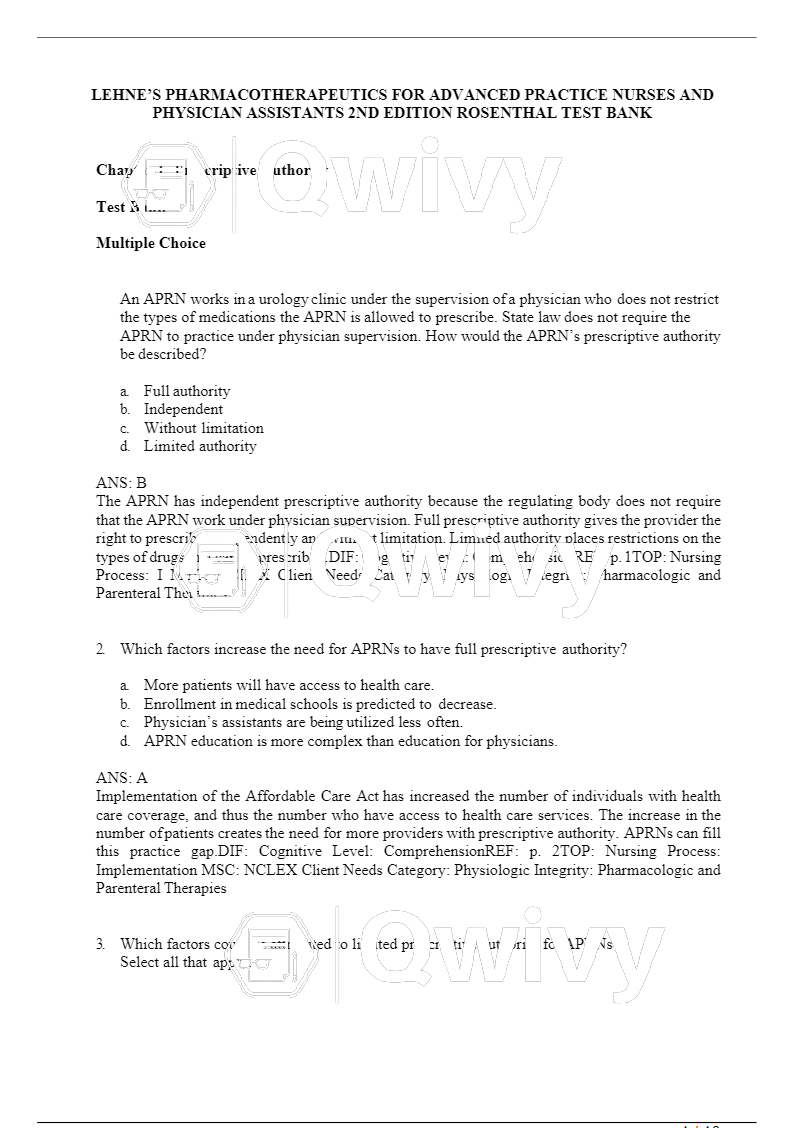
MIDTERM EXAM
Question 1
0 out of 0 points
Gas exchange occurs in which of the respiratory system's structures?
Selected
Answer: Trache
a
Correct
Answer: Alveoli
Response
Feedback
:
The alveoli allow air to come in indirect contact with the
bloodstream through the pulmonary capillary system.
This alveolar membrane, which is one cell thick, allows
carbon dioxide to diffuse into the alveoli from the
bloodstream and oxygen to diffuse to the bloodstream
from the alveoli. Sinuses are hollow spaces found in the
skull. The trachea is a structure that allows passage of
gases to and from the gas exchange units (alveoli).
Bronchi are branches of the conducting airways that
allow passage of gases to and from the gas exchange
units (alveoli).
Question 2
0 out of 0 points
A patient with heart failure reports awakening intermittently with
shortness of breath. Which terms appropriately describes this clinical
manifestation?
Selected
Answer: Dyspnea
Correct
Answer: Paroxysmal
nocturnal
1 / 4
Response
Feedback
:
Paroxysmal nocturnal dyspnea refers to intermittent
attacks of severe dyspnea that occur during the night.
Dyspnea is a general term referring to difficulty
breathing. Cyanosis is the appearance of a blue or purple
coloration of the skin or mucous membranes due to the
tissues near the skin surface being low on oxygen.
Bradypnea describes abnormal slowness of breathing.
Question 3
0 out of 0 points
What factor causes a congenital heart disease to produce cyanosis?
Selected
Answer: Left-to-right shunting of
blood
Correct
Answer: Right-to-left shunting of
blood
Response
Feedback
:
Disorders that result in right-to-left shunting cause
cyanosis. A left-to-right shunt occurs when oxygenated
blood from the left side of the heart or aorta flows back
into the right side to be recirculated through the lungs.
The blood reaching the systemic circulation is
oxygenated and the infant is not cyanotic (acyanotic
defect). However, the right side of the heart has an
increased workload because of the extra shunt blood. In
time, the overload of the right side of the heart can result
in right ventricular hypertrophy and high right-sided
heart pressures. Large ventricular septal defects may be
apparent at birth because of rapidly developing rightsided heart failure and a loud systolic murmur. The
majority of atrial septal defects occur at the location of
the foramen ovale. The abnormal septal opening may be
of variable size. Small defects (1 cm) are well tolerated.
Even larger atrial septal defects may be asymptomatic
for many years as long as the shunt flow is left to right
and therefore acyanotic.
Question 4
0 out of 0 points
2 / 4
A patient education intervention that will help decrease the
emergence of resistant infections is to instruct the patient to
Selected
Answer: Take all the antibiotics ordered even if feeling well after
a few days to prevent antibiotic defiant bacteria
Correct
Answer: Take all the antibiotics ordered even if feeling well after
a few days to prevent antibiotic defiant bacteria
Response
Feedback
:
The patient should take all the antibiotics ordered, even if
feeling better, to eradicate the moderately resistant
microorganisms. Viruses are not impacted by
antibacterial medications. Sharing antibiotics indicates
that the full course of the medication isn’t being taken,
and so contributing to the development of resistant
microorganisms. If medication is stopped prematurely,
moderately resistant organisms are selected for and
become the predominant species, making it more difficult
to eradicate next time.
Question 5
0 out of 0 points
Cellular hypoxia results in
Selected
Answer: Failure of the sodium-potassium
pump
Correct
Answer: Failure of the sodium-potassium
pump
Response
Feedback:
Hypoxia is a loss of oxygen to the cell that causes ATP
activity to cease. ATP provides the power required to
drive the sodium-potassium pump. pH decreases in
hypoxia (respiratory acidosis). Hypoxia is a loss of
oxygen to the cell that causes ATP activity to cease.
Deposits of calcium salts occur in conditions of altered
calcium intake, excretion, or metabolism.
Question 6
0 out of 0 points
3 / 4
What is the underlying problem common among all types of shock?
Selected
Answer: Generalized vasodilation
Correct
Answer: Inadequate cellular
oxygenation
Response
Feedback
:
Although each type of shock has specific characteristics,
all are associated with a deficiency of cellular oxygen
consumption. Inadequate cellular oxygenation may result
from decreased cardiac output, maldistribution of blood
flow, or reduced blood oxygen content. The impaired
oxygen utilization by cells may lead to cell death, organ
dysfunction, and stimulation of inflammatory reactions.
Cardiac failure can be an outcome, but is not a common
cause in all types of shock. Vasodilation occurs in only
selective forms of shock. Faulty compensatory
mechanisms may contribute to the seriousness of all
shocks but that is not the cause of all forms of shock.
Question 7
0 out of 0 points
What is the name for the mRNA sequences that contain only the
wanted segments?
Selected
Answer: PremRNA
Correct
Answer: Exon
Response
Feedback
:
An exon is the mRNA sequence that contains only the
wanted segments. Introns are the unwanted areas that
are removed in the nucleus by a complex splicing
process, thus leaving exons. Pre-mRNA is the original
RNA transcript before removal of bases that are
unnecessary. Spliceosomes are the areas of the nucleus
that are a specialized RNA protein complex that removes
introns.
Question 8
0 out of 0 points
Powered by qwivy(www.qwivy.org)
4 / 4
| Version | 2021 |
| Category | TEST BANK |
| Pages | 57 |
| Language | English |
| Comments | 0 |
| Sales | 0 |















{{ userMessage }}





